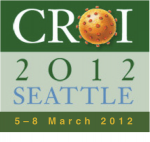Tenofovir prodrug: 10 day monotherapy study sets dose at 25 mg for easier coformulation
1 April 2012. Related: Conference reports, Antiretrovirals, CROI 19 (Retrovirus) 2012.
 Simon Collins, HIV i-Base
Simon Collins, HIV i-Base
Further data on the development of a tenofovir prodrug from Gilead (compound name GS-7340) were presented by Peter Ruane MD from Los Angeles. [1]
This compound is expected to have higher potency at much lower concentrations in all cell types with EC50s compared to the current formulation of tenofovir disoproxil fumerate (TDF) of 0.003 vs 0.015 uM in PBMCs and 0.014 vs 0.06 uM in macrophages. Last year at CROI a similar dose finding 10-day monotherapy study reported viral load reductions of about -1.0 log at 50 mg and 150 mg doses, compared to 0.5 log with TDF, with plasma concentrations of GS-7340 that were 88% lower and intracellular concentrations 4-fold higher compared to TDF.
This current study randomised 38 treatment-nanaïve or experienced (but tenofovir sensitive) patients to 10 days GS-7340 monotherapy using 8 mg, 25 mg and 40 mg with placebo and TDF arms as controls. The primary endpoint was the time-weighed average change in viral load (DAVG) at day 11.
Baseline characteristics included: age 38 years, 97% male and 50% white/38% African American. The mean viral load and CD4 counts were 31,000 copies/mL and 478 cells/mm3 respectively.
DAVG results were –0.76, –0.94, –1.13, –0.48 and –0.01 log copies/mL in the 8 mg, 25 mg, 40 mg, TDF and placebo arms respectively with median viral load reductions –1.08 (8 mg); –1.46 (25 mg); –1.73 (40 mg), –0.97 (TDF) and –0.07 (placebo). There were significant differences between both the 25 mg and 40 mg arms when compared to TDF, but not for the 8 mg dose.
Plasma tenofovir exposures across the GS-7340 groups were approximately 80 to 97% lower compared to TDF with intracellular concentrations in PBMCs 7-fold higher in the 25 mg dose and 20 fold higher with the 40 mg dose.
There were no clinically significant laboratory abnormalities or drug-related serious adverse events, no discontinuations and no evidence of resistance over the 10 days.
Phase 2 studies that are already ongoing or soon to enroll are using the 25 mg dose for development in two fixed dose formulations. One substitutes GS-7340 for TDF in Quad with elvitegravir, cobicistat and FTC (in study 292-0102) and a second in coformulation with darunavir, cobicistat and FTC to be the first once-daily single-pill PI combination (in study 299-0102).
comment
The discussion after this presentation included surprise that the dose selected for development was to be based on such a small short study and that the greater virological efficacy in the 40 mg group was not going to be explored further. Also that this decision was largely driven by the ease of coformulation with the lower milligram dose.
Another question was whether increased intracellular concentrations of GS-7340 accumulated in renal tubule cells. Although no renal concerns were seen after 10 day exposure this will be an important aspect of further studies. In vitro data in MT-2 cells, PBMCs and macrophages did not find concerns from increased levels of intracellular diphosphates. CNS penetration of GS-7340 is expected to be similar to tenofovir DF and it may also have activity against HBV.
References
- Ruane P et al. GS-7340 25 mg and 40 mg demonstrate superior efficacy to tenofovir 300 mg in a 10-day monotherapy study of HIV-1+patients.19th CROI, 5–8 March 2012, Seattle. Oral abstract 103.
http://www.retroconference.org/2012b/Abstracts/44081.htm - Markowitz M et al. GS-7340 demonstrates greater declines in HIV-1RNA than TDF during 14 days of monotherapy in HIV-1-infected subjects. 18th CROI, 27 February–3 March 2011, Boston. Oral abstract 152LB.
http://www.retroconference.org/2011/Abstracts/42549.htm

